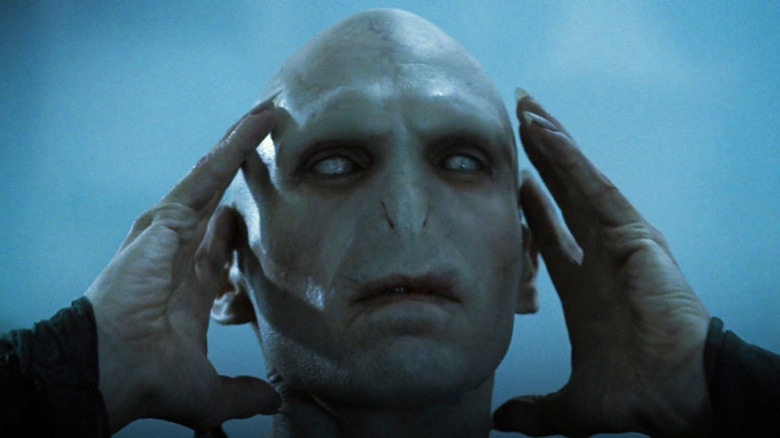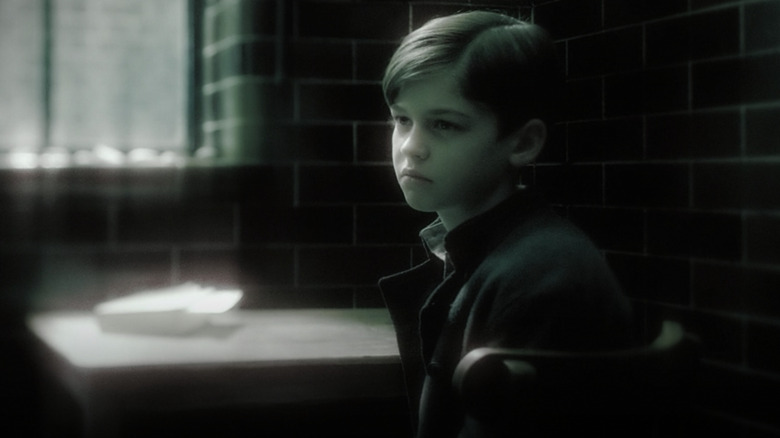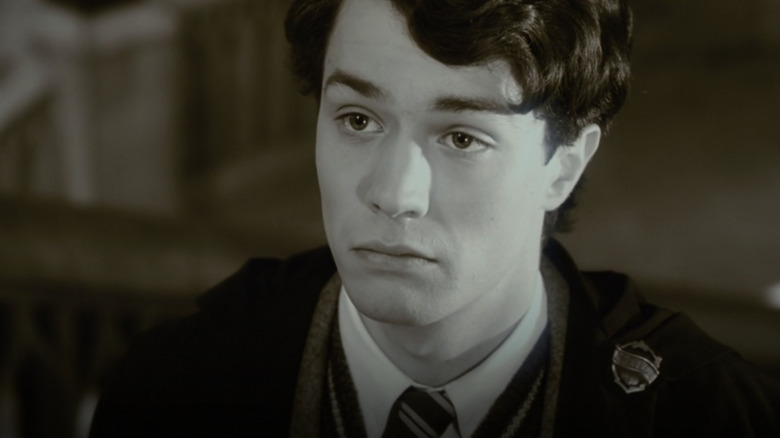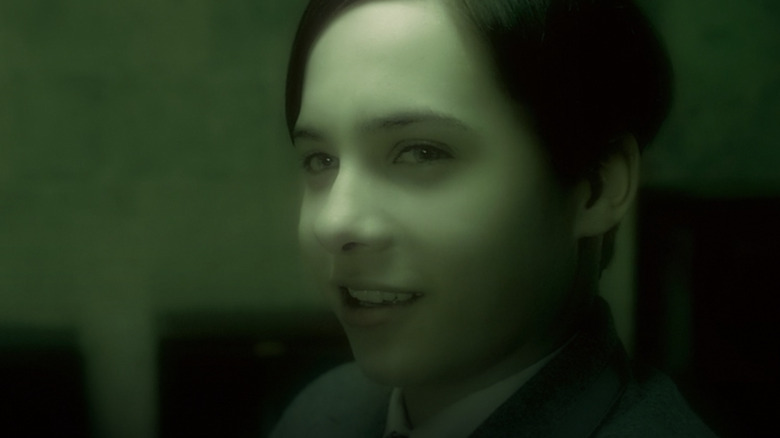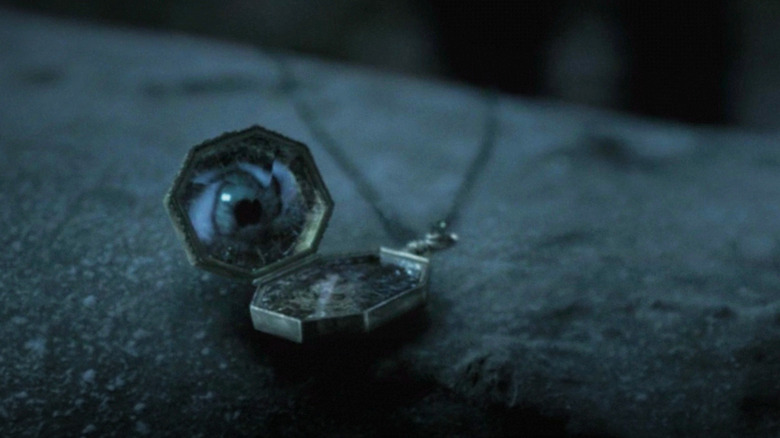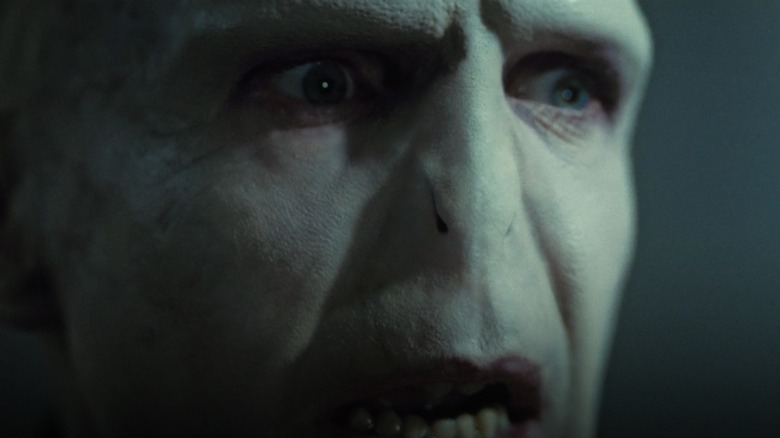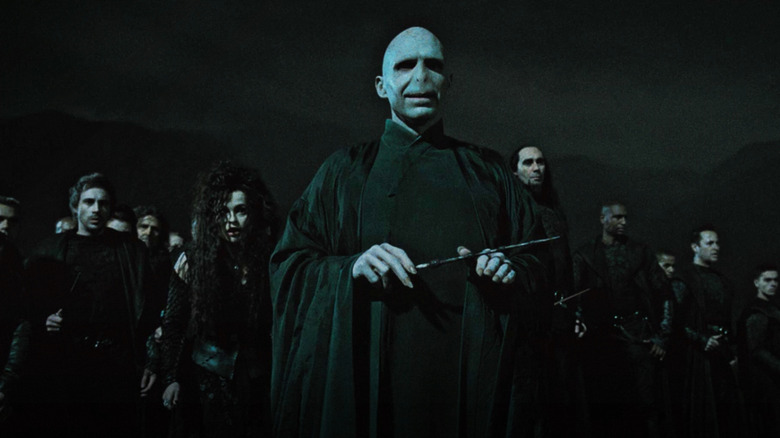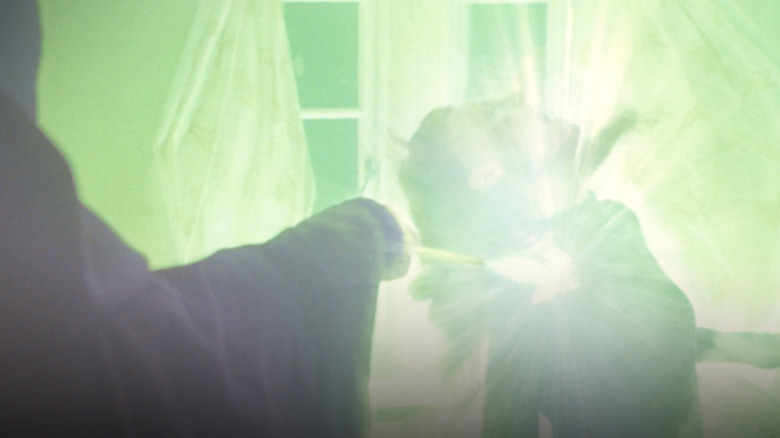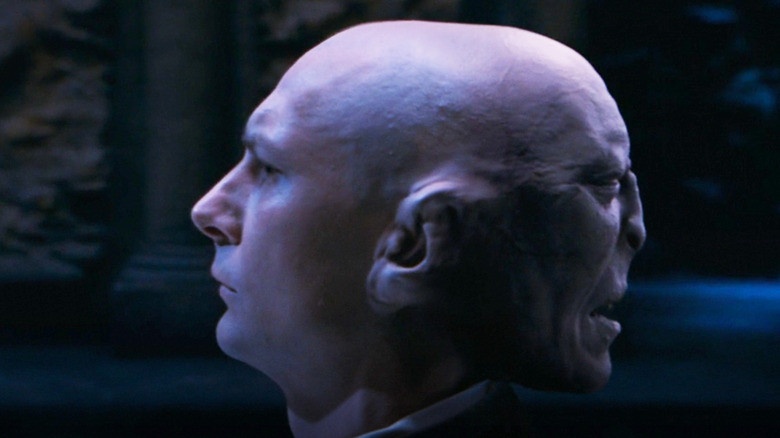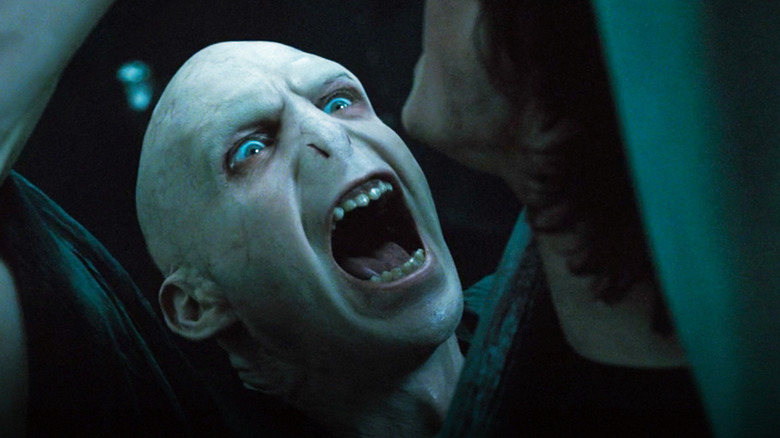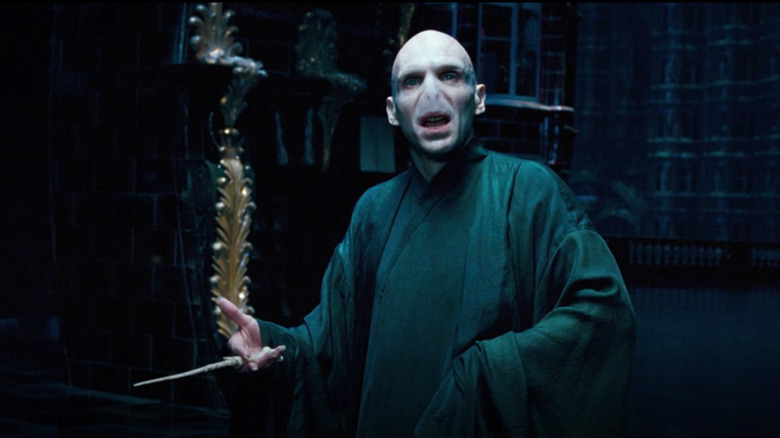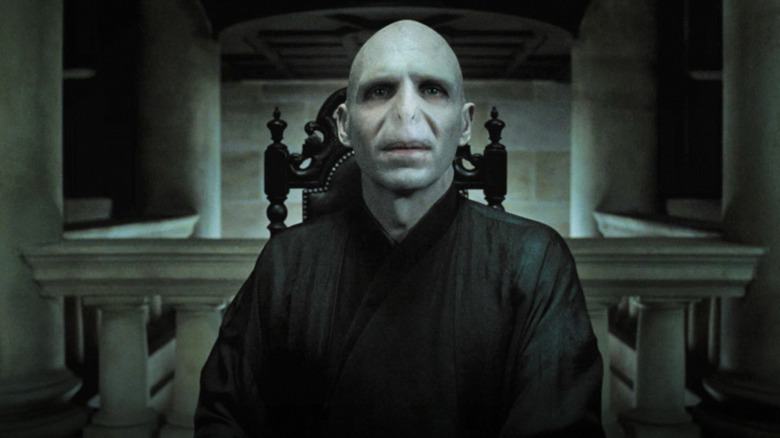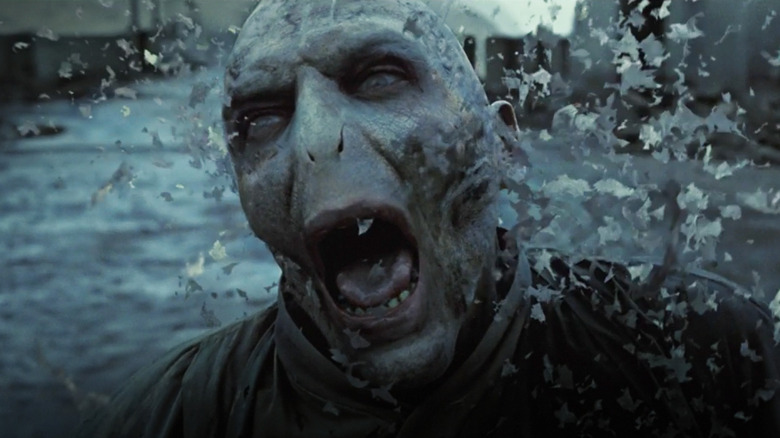Voldemort's Entire Harry Potter Timeline Explained
Few pop culture evil-doers are as memorable as Tom Riddle, aka Lord Voldemort, the overarching antagonist of the uber-popular "Harry Potter" franchise. Consistently ranked as one of the best villains of all time, Voldemort is a cultural icon and the nose-less face of fear for an entire generation, and likely future generations to come. Granted, a big part of that is the globe-spanning reach of the "Harry Potter" phenomenon itself. But even taken simply on his own merits, Voldemort is an undeniably compelling character. What makes this particular villain, who under other circumstances might have been just another evil wizard, such a fascinating and terrifying individual?
The answer lies in how Voldemort is deployed as an antagonist throughout the story. At the beginning of the "Harry Potter" series, Voldemort is mostly the ghost of a threat, a name that must not be spoken, and a cloud hanging over the titular protagonist's life. As the story goes on, however, more and more information about him comes to light. By the end, we know more about Voldemort than we could have ever suspected. Much of this knowledge comes in the form of magical flashbacks and educated speculation, but a clear timeline of Voldemort's life is established. It's thorny, it's compelling, and it's high time we unpacked it! This is Voldemort's entire story, explained.
Born of magic and misery
Voldemort is no more sympathetic for the circumstances of his birth and troubled childhood, but boy was that childhood ever troubled — starting with his very conception. Voldemort's mother was a witch named Merope Gaunt who became infatuated with a Muggle named Tom Riddle. Though Riddle did not return Merope's affections, she was able to magically coerce him into marrying and then impregnating her. Hoping that Riddle might, by this point, remain by her side — if only for the baby's sake — Merope revealed her actions to her husband, who immediately fled. She languished in poverty, either unwilling or unable to perform magic, before arriving at the doorstep of Wool's Orphanage in London. She died there, shortly after delivering her child on New Year's Eve, 1926.
Bearing the same name as his father, Tom Marvolo Riddle was raised in that orphanage for the first 11 years of his life, until he was found by the wizard Albus Dumbledore. After testing Riddle's magical abilities, Dumbledore told him of his birthright and invited him to study at Hogwarts School of Witchcraft and Wizardry, an invitation the boy accepted eagerly. His dark delight at being classified as "special," combined with hints of a shadowy history of using his latent powers to torment other children, made Dumbledore suspicious of him from the very beginning. But no one could have predicted the monster he would ultimately become.
Schooled in Slytherin
Upon his arrival at Hogwarts in 1938, Tom Riddle was immediately sorted into Slytherin House — not surprising, since he's a direct descendant of Salazar Slytherin, the house's founder. He loved the school and quickly developed a reputation as a model student with a brilliant mind, becoming a favorite of nearly all his instructors. Despite this warm welcome, the seeds of his transformation into Lord Voldemort were planted during his time at Hogwarts. Here, Riddle first gathered his group of servile companions, who would eventually be known as the Death Eaters, and also committed his first murder.
While at Hogwarts, Riddle became obsessed with investigating his own family history, and eventually learned of his Slytherin descent. That knowledge allowed him to discover, and then to open, the mysterious Chamber of Secrets, which had been constructed beneath the school by Slytherin himself. Using his ability to speak to snakes (another gift of his ancestry), Riddle took control of the basilisk that inhabited the Chamber and sent it up to terrorize the student body — particularly those of Muggle descent. When the basilisk killed a girl named Myrtle Warren, the incident nearly caused Hogwarts to be shut down. To prevent this, Riddle framed Rubeus Hagrid for his crime, earning a trophy for "Special Services to the School" in the process. He used Warren's murder to create his first Horcrux.
The Riddle murders
As dedicated "Harry Potter" readers know, a Horcrux is a magical item in which a wizard places a piece of their soul, thereby protecting them from death. The catch, of course, is that ripping off that piece of soul requires a deliberate act of murder.
From the beginning, death was the ultimate enemy Riddle sought to conquer. He blamed his mother, Merope, for dying, and resolved that he himself would never succumb to such a fate. As a result, the creation of Horcruxes became Riddle's obsession. He was perfectly willing to kill in pursuit of his own immortality — or, as it turned out, for revenge.
Shortly after the death of his first victim, Myrtle Warren, in 1943, Riddle managed to track down the last member of his mother's family: His uncle Morfin, who still lived in the home he and Merope once shared with their father, Marvolo. From Morfin, Riddle learned of his father, Tom Riddle Sr., who (understandably) deserted Merope at the earliest opportunity. Riddle responded to this information by tracking down and murdering his father, as well as his paternal grandparents, in their own home. Once again, he was able to pin the crime on someone else — in this case, Morfin. From the now-empty house in which the last of the Gaunts resided, Riddle took their hereditary signet ring. It became his second Horcrux.
Riddle's post-graduate studies
Two notable things occurred prior to Riddle's graduation from Hogwarts in 1945. The first was a secret conversation with Horace Slughorn, head of Slytherin House, about what might happen to a wizard who dared to create more than one Horcrux. Riddle's ultimate goal was to produce a total of six Horcruxes, dividing his soul into seven parts and thereby achieving near-total immortality. Having always collected trophies and feeling a special connection to Hogwarts, he decided to store the next four pieces of his soul inside items that had belonged to the school's founders. This fact informs the second notable thing that happened before he left school: Riddle managed to talk the location of Rowena Ravenclaw's diadem out of her ghostly daughter, Helena. He would later travel to Albania to retrieve it, and transform it into a Horcrux.
After graduation, Riddle turned down prestigious job offers in favor of a position in the disreputable antique shop, Borgin and Burkes. Here, he had opportunities to get his hands on celebrated magical heirlooms. This plan bore fruit sometime in the late 1950s, when he acquired Salazar Slytherin's ancestral locket and a cup that once belonged to Helga Hufflepuff. Both had been in the possession of the elderly Hepzibah Smith, whom Riddle charmed and murdered. Once again, he set up someone else to take the fall: Smith's house elf, Hokey. Afterward, Riddle disappeared. His whereabouts and activities went almost entirely unknown for 10 years.
Becoming Lord Voldemort
Few have any idea of what Voldemort was doing for the majority of the 1960s. He seems to have spent his time traveling the world and enhancing his magical abilities, both in widely-practiced magical disciplines like Legilimency — the art of entering another person's mind — and the forbidden realms of the Dark Arts. By the time he resurfaced, he had formally abandoned the name Tom Riddle and adopted Voldemort as his primary sobriquet. He had also turned all his stolen artifacts into Horcruxes, for a total of five. His physical appearance had begun to twist and warp, as a result of his continued assault on his own soul.
In the late 1960s, Voldemort returned to Hogwarts, ostensibly to apply for a position as the school's Defense Against the Dark Arts teacher. He'd done the same in 1945, but had been refused, due to his youth. Hogwarts had a new headmaster in Albus Dumbledore, who had been keeping tabs on Voldemort's doings, and was growing ever more suspicious. Dumbledore saw through his act and denied Voldemort's request (possibly resulting in a curse being placed on that particular teaching position). In fact, Voldemort's true goal was to acquire the Sword of Gryffindor, the only known relic of Hogwarts founder Godric Gryffindor, to turn into his final Horcrux. In this, he failed. But while in the castle, he succeeded in hiding another Horcrux — the diadem — within Hogwarts' mysterious Room of Requirement.
The First Wizarding War
Voldemort spent the ensuing years steadily gaining followers by appealing to those wizards who shared his hatred of Muggles and Muggle-borns, as well as through coercion and intimidation. Collectively, they were known as Death Eaters, and in 1970, they declared war on the wizarding world by engaging in a series of horrific acts of terrorism, torture, and murder. They were joined by many giants and werewolves, who had lived on the margins of wizarding society for decades, as well as Inferi, corpses reanimated by dark magic. The war raged for 11 years, with Voldemort and his army openly attacking wizards and Muggles alike, as well as infiltrating the wizarding government. They were opposed by Aurors — dark wizard catchers whose tactics became more and more extreme as the war went on — and the Order of the Phoenix, a secret society created by Dumbledore himself. Hogwarts, it should be noted, was left untouched by the war, likely through a combination of Voldemort's own regard for the school and his fear of Dumbledore, his only magical equal.
Voldemort also took steps to secure his remaining Horcruxes. He placed the diary and the cup into the hands of devoted followers Lucius Malfoy and Bellatrix Lestrange, returned the ring to the Gaunt house under a powerful curse, and concealed the locket in a hidden cave with numerous magical defenses. In 1979, disillusioned Death Eater Regulus Black sacrificed his life to retrieve the latter object.
The prophecy and the Potters
The First Wizarding War ended in 1981, but the seeds of its conclusion were planted more than a year prior. In early 1980 (or possibly late 1979), word reached Voldemort of a prophecy that had been delivered to Dumbledore by the unlikely seer Sybill Trelawney. It proclaimed that "the one with the power to vanquish the Dark Lord will be born as the seventh month dies," to parents "who have thrice defied him." Two children born in July 1980 fit that description: Neville Longbottom and Harry Potter. Possibly because Harry shared his own half-blood heritage, Voldemort decided he was the prophesied threat. Harry's parents, James and Lily, were placed under a seemingly impenetrable concealment spell, only to be betrayed by their treacherous friend, Peter Pettigrew. Shortly after Harry's first birthday, Voldemort entered the Potter home and killed both parents, before turning his wand upon their only child.
What happened next fundamentally altered the course of history. In giving up her life for her son, Lily Potter imbued him with an ancient and powerful magical protection. Voldemort's curse, which had killed so many witches and wizards, bounced off Harry and rebounded upon its caster, killing Voldemort instead. Moreover, Voldemort's soul had, by this point, been so heavily damaged that the curse caused another piece of it to tear off. This soul-scrap merged with Harry himself, making him Voldemort's sixth Horcrux — though this wouldn't be known to anyone for years.
Haunting the wizarding world
Of course, Voldemort couldn't truly be killed — not with his Horcruxes still intact. However, his existence over the next decade or so could hardly be called life as we know it. His physical form was gone, and with it, his ability to use magic. Having retreated to the forests of Albania, Voldemort was essentially a ghost, capable only of possessing the bodies of living things. Even this was small recompense, as animals quickly died after possession, and he didn't dare risk entering human society.
One decade after his body was destroyed, however, a human came to him. Quirinus Quirrell, a professor at Hogwarts, had taken a year's sabbatical from the school, presumably to gain experience in the real world as opposed to the academic realm of books and students. In fact, Quirrell was a deeply ambitious wizard who dreamed of becoming someone important, and specifically set out on a quest to find what remained of Voldemort. To his extreme misfortune, he was successful — Voldemort possessed him completely, controlling Quirrell in both body and mind. He was eventually able to warp him so thoroughly, the back of Quirrell's head housed Voldemort's face. In 1991, Voldemort used Quirrell to infiltrate Hogwarts and attempt to gain possession of the philosopher's/sorcerer's stone, which could fully restore him to life. His plan was foiled, however by new Hogwarts student Harry Potter. By the end of their encounter, Quirrell was dead, and Voldemort was once again reduced to ghostliness.
Voldemort's return to power
Following his failure with Quirrell, Voldemort returned to hiding in Albania, where he remained until 1994. That was the year that Peter Pettigrew, who had been presumed dead, returned to his master's side. He brought with him an unwitting witch named Bertha Jorkins, who revealed under torture that Hogwarts was about to host the prestigious Triwizard Tournament. Jorkins also revealed that one of Voldemort's most devoted followers, Barty Crouch Jr., was alive and being concealed by his father. Afterwards, Jorkins, whose body and mind were too decimated by torture for Voldemort to possess, was killed. Her murder was used to create Voldemort's final Horcrux: his newfound snake companion, Nagini. Pettigrew was able to build a fragile, but physical body for Voldemort to inhabit temporarily during this period.
Jorkins' information enabled Voldemort to devise the plan that would ultimately restore him to power in 1995. This involved returning to England, freeing Crouch, having him impersonate new Hogwarts teacher Alastor Moody, and enchanting the Triwizard Cup so that it would teleport the tournament's winner to the Riddle family home, where Voldemort now resided. It also ensured that 14-year-old Harry Potter would be that winner. After capturing Harry, Pettrigrew used his blood as the final ingredient of a spell that brought Voldemort fully back to life. This also nullified the protection afforded Harry by his mother's sacrifice. At last in possession of a body of his own again, Voldemort had finally returned.
The Death Eaters' secret war
While Harry managed to survive a duel with Voldemort and escape back to Hogwarts, the Death Eaters, most of whom had managed to avoid incarceration after the First Wizarding War, returned to their leader's side. Those who had been imprisoned soon found themselves freed. For the rest of 1995 and a large part of 1996, however, these facts were suppressed by the Ministry of Magic. This allowed Voldemort and his followers to spend a full year operating in the shadows, manipulating the Ministry and building their ranks once again. Dumbledore, who had been anticipating Voldemort's return for years, responded by re-forming the Order of the Phoenix. A 1996 clash between the Death Eaters and the Order on the grounds of the Ministry itself eventually led Voldemort to come out of hiding sooner than he'd hoped.
Using their mental connection, Voldemort tricked Harry and his friends into breaking into the Ministry's Hall of Prophecy and retrieving the prediction made by Sybill Trelawney. When the Death Eaters attacked the students, the Order appeared to combat them. During the battle, the prophecy was destroyed, Dumbledore himself arrived to duel Voldemort, and Sirius Black was killed. In its wake, the Ministry had no choice but to acknowledge Voldemort's return.
Sometime after these events, Voldemort supposedly conceived a child with his most zealous follower, Bellatrix Lestrange. The full details of their daughter's conception and birth are murky, however, and only relevant to the 2016 play, "Harry Potter and the Cursed Child."
The Second Wizarding War
The battle at the Hall of Prophecy heralded the start of the Second Wizarding War, which began as the first one did: with terrorism, torture, and murder. Voldemort's forces, which again included giants and werewolves, as well as the fiendish prison guards known as Dementors, swept across the country, targeting Muggles, Muggle-borns, and anyone who got in their way. They also continued their infiltration of the Ministry, which, despite its newfound acceptance of the threat, was entirely incapable of combating it. Dumbledore remained a powerful obstacle, as did Harry Potter: Together, they learned the truth about Voldemort's Horcruxes and began tracking them down in an effort to render him mortal once more. Harry, it turned out, had destroyed the diary without knowing it was a Horcrux back in 1993, and Dumbledore managed to destroy the ring, though he fell prey to its curse in the process.
In 1997, Harry and Dumbledore set out to retrieve the locket from its cave, being ignorant of Regulus Black's actions years prior. When they returned to Hogwarts, a weakened Dumbledore was confronted by Draco Malfoy, now a Death Eater. Malfoy had been assigned the task of killing Dumbledore, but it was double agent Severus Snape who ended up casting the killing curse upon the headmaster. This was actually by design: After Dumbledore realized the ring's curse was killing him anyway, he ordered Snape to be the one to kill him properly. No one but Snape knew this at the time, however.
The Elder Wand
After Dumbledore's death, Voldemort was able to take near-total control of the wizarding world. Harry Potter, however, remained at large, and continued hunting Horcruxes alongside his trusted companions, Ron Weasley and Hermione Granger. Together, they found and destroyed the real locket. Voldemort, meanwhile, was becoming increasingly frustrated with his inability to kill Harry, and remained ignorant of the magic that still bound them together. Seeking a solution, he searched for the legendary Elder Wand, whose ownership transfers when its holder is defeated in battle. Eventually, Voldemort determined that the master of the Elder Wand had been Dumbledore, and broke open his tomb to retrieve it. Upon further reflection, however, he came to believe that the wand's true allegiance was to Severus Snape. He killed Snape to gain mastery.
Harry, Ron, and Hermione returned to Hogwarts, where they started the battle that would ultimately see the Death Eaters defeated once more. The trio also managed to recover and destroy the cup and the diadem, while Neville Longbottom dispatched Nagini. Ironically, Voldemort himself accidentally destroyed the secret Horcrux hiding in Harry when he attempted to kill his foe with the Elder Wand. With every Horcrux gone, Harry then revealed his master stroke: He was the true master of the Elder Wand. When Voldemort tried to murder Harry one final time, Harry used the Elder Wand to reflect the curse, which again rebounded on its caster, finally killing Lord Voldemort once and for all.
